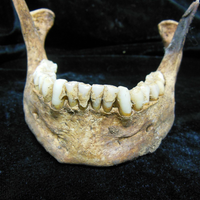Login
Subscribeancient humans

Dog Ancestry Provides Clues to Ancient Human Activities
Niki Spahich, PhD | Sep 1, 2022 | 3 min read
Researchers combined evidence found in dog genomes with physical materials recovered from archeological sites to discover factors behind major societal changes.

DNA Analyses Illuminate Origins of Farming, Ancestral Languages
Andy Carstens | Aug 26, 2022 | 3 min read
The findings suggest a new hypothesis of Indo-European language evolution.

South African Hominin Fossils Predate Lucy, Analysis Suggests
Andy Carstens | Jun 29, 2022 | 2 min read
A newer dating technique using cosmogenic isotopes finds Australopithecus remains from the Sterkfontein caves to be about 1 million years older than previous estimates, potentially changing scientists’ understanding of humanity’s origins.

First Human Genome Sequenced from Ancient Pompeii
Alejandra Manjarrez, PhD | May 26, 2022 | 4 min read
The genome is from a male who was likely in his late thirties when the historic Mount Vesuvius eruption occurred. The analyses suggest he is related to the diverse Imperial Roman population of the time, and that he may have suffered from spinal tuberculosis.

Marilyn Fogel, Biogeochemist and “Isotope Queen,” Dies at 69
Andy Carstens | May 25, 2022 | 3 min read
Fogel mined information from isotopes to explore modern and ancient ecosystems, climatic changes, and evolution.

Ancient DNA Sheds New Light on Africa’s Stone Age
Sophie Fessl, PhD | Feb 23, 2022 | 6 min read
The oldest DNA yet isolated from humans in Africa reveals long-range migrations around 50,000 years ago, which likely played a role in the Middle to Later Stone Age transition.

Paleoanthropologist Richard Leakey Dies at Age 77
Chloe Tenn | Jan 3, 2022 | 3 min read
The Kenyan fossil finder is known for his discoveries of various Stone Age artifacts and ancient human skulls and skeletons.

Gene Variant Points to Starvation’s Evolutionary Legacy
Sophie Fessl, PhD | Sep 28, 2021 | 4 min read
Ancient and modern genomes reveal that a variant of the human growth hormone receptor likely helped our ancestors survive when food was scarce.

Ancient Human Footprints in New Mexico Dated to Ice Age
Rachael Moeller Gorman | Sep 23, 2021 | 4 min read
Researchers excavated human footprints out of a small bluff next to a dried-up playa lake and radiocarbon-dated embedded seeds to around 23,000 years ago. Their results suggest that people entered the Americas thousands of years earlier than the accepted estimate.

65,000-Year-Old Cave Markings Made by Neanderthals: Study
Lisa Winter | Aug 3, 2021 | 2 min read
An analysis concludes that pigments were transported into the cave, and the marks were made with intention, though their ultimate meaning remains unknown.

“Dragon Man” May Replace Neanderthal as Our Closest Relative
Amanda Heidt | Jun 25, 2021 | 8 min read
A massive, well-preserved skull discovered in China in the 1930s belongs to a new species called Homo longi, researchers report, but experts remain skeptical about the evidence.

Early Humans’ Brains Were More Apelike than Modern
Abby Olena, PhD | Apr 8, 2021 | 3 min read
Impressions that ancient brains left in fossilized skulls reveal that the first human ancestors to migrate out of Africa had much more primitive brains than previously thought.

Questions Raised About How an Ancient Hominin Moved
Abby Olena, PhD | Feb 24, 2021 | 4 min read
A new analysis of the hand of the 4.4-million-year-old partial skeleton of Ardipithecus ramidus indicates that the human ancestor may have climbed and swung through trees like chimpanzees do.

The Biggest Science News of 2020
Kerry Grens | Dec 23, 2020 | 6 min read
Neanderthal DNA surprises in modern humans, the first blood test for Alzheimer’s, a discovery of new human salivary glands, and, oh yeah, a pandemic

Ancient Beads Point to Far-Flung Relationships in Southern Africa
Shawna Williams | Jul 13, 2020 | 5 min read
An isotopic analysis of eggshell beads dating back more than 30,000 years indicates that they helped build networks that stretched for hundreds of kilometers.

Skulls from the Yucatán Peninsula a Clue to Early American Settlers
Alejandra Manjarrez, PhD | Apr 7, 2020 | 8 min read
The crania of individuals who lived in the Yucatán Peninsula during the late Pleistocene show a high degree of anatomical diversity among them, and their skull shapes differ from that of other North American populations of the time.

Africans Have More Neanderthal DNA than Previously Thought
Jef Akst | Jan 30, 2020 | 4 min read
A new analysis of more than 2,500 human genomes indicates that modern Eurasians who acquired Neanderthal DNA during past interbreeding migrated back to Africa and spread those sequences.

Caution Urged for Comparing Ancient and Modern Humans’ Oral Microbes
Alejandra Manjarrez, PhD | Aug 7, 2019 | 4 min read
Microbial species that are commonly associated with oral diseases in modern humans are unreliable proxies for determining tooth health status in ancient samples, a new study finds.

Image of the Day: Stale Cereal
Chia-Yi Hou | Jun 10, 2019 | 1 min read
Archaeologists find ring-shaped objects made from grains at a site in Austria thought to date back to 960 BCE.
